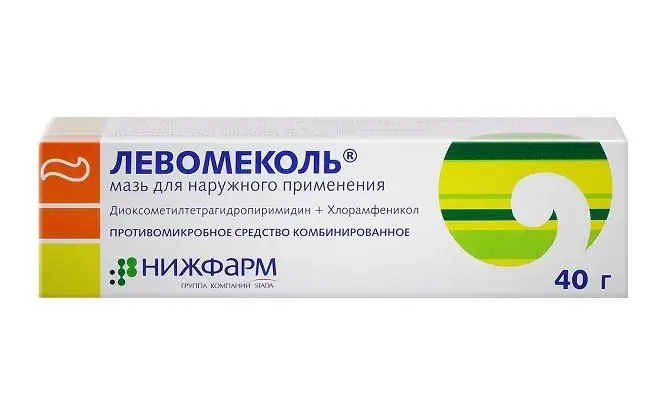- Author Rachel Wainwright [email protected].
- Public 2023-12-15 07:39.
- Last modified 2025-11-02 20:14.
Bactroban
Bactroban: instructions for use and reviews
- 1. Release form and composition
- 2. Pharmacological properties
- 3. Indications for use
- 4. Contraindications
- 5. Method of application and dosage
- 6. Side effects
- 7. Overdose
- 8. Special instructions
- 9. Application during pregnancy and lactation
- 10. Use in childhood
- 11. In case of impaired renal function
- 12. Use in the elderly
- 13. Analogs
- 14. Terms and conditions of storage
- 15. Terms of dispensing from pharmacies
- 16. Reviews
- 17. Price in pharmacies
Latin name: Bactroban
ATX code: D06AX09
Active ingredient: mupirocin (Mupirocin)
Manufacturer: Glaxo Operations UK, Limited (Great Britain)
Description and photo update: 2019-26-08

Bactroban is a topical antibacterial drug.
Release form and composition
Dosage forms of Bactroban:
- nasal ointment: almost white or white (in a cardboard box 1 aluminum tube 3 g each, the kit includes a plastic tip and a plastic screw cap);
- ointment for external use: almost white or white, homogeneous consistency (in a cardboard box 1 aluminum tube of 15 g, the set includes a screw cap with a tip for opening).
1 g of ointment for external use contains:
- active substance (10% surplus is included in the standard series): mupirocin - 0.022 g;
- auxiliary components: macrogol 400 - 0.587 g; macrogol 3350 - 0.391 g.
1 g of nasal ointment contains:
- active substance: mupirocin calcium - 0.0215 g (corresponds to the content of mupirocin - 0.02 g);
- auxiliary components: white soft paraffin - 0.9296 g, softizan 649 - 0.0489 g.
Pharmacological properties
Pharmacodynamics
Bactroban is a broad spectrum antibiotic for local and external use. The active substance is mupirocin, obtained by fermentation of Pseudomonas fluorescens.
Mupirocin, blocking protein synthesis in a bacterial cell, inhibits isoleucyl transfer RNA synthetase.
Due to the specific mechanism of action and unique chemical structure, mupirocin is not characterized by cross-resistance with other antibiotics used in clinical practice.
When applied topically in MIC (minimum inhibitory concentrations), the substance has bacteriostatic, and in higher concentrations, bactericidal properties.
The spectrum of antibacterial activity of mupirocin:
- gram-negative anaerobes: Citrobacter freundii, Pasteurella multocida, Haemophilus influenzae, Neisseria meningitidis, Neisseria gonorrhoeae, Branhamella catarrhalis, Proteus mirabilis, Proteus vulgaris, Enterobacter aerogenes, Enterobacter cloacae, Bordete;
- gram-positive aerobes: Staphylococcus aureus (including strains showing resistance to methicillin and producing β-lactamases), Staphylococcus epidermidis and other coagulase-negative Staphylococcus spp., Streptococcus spp.;
- insensitive: species of the family Enterobacteriaceae, anaerobes, Micrococcus, gram-negative non-fermenting bacilli, Corynebacterium spp.
Pharmacokinetics
Bactroban is for topical / topical use only.
The absorption of mupirocin in the form of a nasal ointment through a healthy and damaged nasal mucosa is insignificant (up to 1% of the dose is excreted in the form of monic acid in the urine).
Mupirocin in the form of an ointment for external use is poorly absorbed through intact human skin. Absorbed through damaged skin, the substance is rapidly metabolized to inactive monic acid, after which it is rapidly excreted by the kidneys.
Indications for use
Nasal ointment
- carriage of staphylococcal infection in the nasal cavity, including carriage of Staphylococcus aureus (including methicillin-resistant strains);
- Staphylococcus aureus infection in patients on continuous ambulatory peritoneal dialysis or hemodialysis (prophylaxis).
Ointment for external use
- primary skin infections: ecthyma, furunculosis (including furuncles of the auricle and external auditory canal), folliculitis, impetigo (treatment);
- secondary skin infections: infected eczema, trauma (abrasions, insect bites), minor burns and wounds that do not require hospitalization (treatment);
- bacterial infections with minor cuts, wounds, abrasions and other uncontaminated skin lesions (prevention).
Contraindications
Absolute:
- age up to 12 years (nasal ointment);
- lactation period, in the case of using an ointment for external use in order to prevent bacterial infection of nipple cracks;
- individual intolerance to the components of the drug, including a burdened history.
Relative (Bactroban is prescribed under medical supervision):
- moderate to severe renal failure (topical ointment);
- old age (ointment for external use);
- pregnancy and lactation.
Instructions for the use of Bactroban: method and dosage
Ointment for external use is applied in a thin layer to the cleansed affected area of the skin 1-3 times a day, after which you can apply a bandage. The duration of the course of treatment is from 7 to 10 days.
A small amount of Bactroban nasal ointment is placed in each nostril 2 times a day. After placing the ointment intranasally, for its better distribution, it is necessary to close the nose well with your fingers and press several times on the nasal passages on both sides. The recommended course of treatment is 5 days.
Side effects
Bactroban is usually well tolerated, but isolated cases of itching, burning, dry skin, flushing, urticaria, edema, and contact dermatitis have been reported.
Overdose
Information on overdose of mupirocin is limited.
There is no specific therapy. In case of overdose, supportive treatment is prescribed and, if necessary, appropriate monitoring of the patient's condition.
special instructions
For patients with impaired renal function, dose adjustment of Bactroban is not required.
After using the drug, wash your hands thoroughly to avoid getting the ointment in your eyes.
When using the drug, it should be remembered that the systemic absorption of mupirocin increases with a violation of the integrity of the skin.
Long-term use of Bactroban can cause excessive growth of microorganisms insensitive to mupirocin.
Application during pregnancy and lactation
According to the instructions, Bactroban during pregnancy / lactation can be used only after the doctor assesses the ratio of the expected benefit to the possible risk (the safety profile has not been studied). No signs of reproductive toxicity were found in animal studies.
If Bactroban external ointment is used to prevent bacterial infection of nipple cracks, breastfeeding should be interrupted.
Pediatric use
Bactroban nasal ointment is contraindicated in patients under 12 years of age because the safety profile has not been studied.
With impaired renal function
Bactroban ointment for external use in moderate to severe renal failure should be used with caution.
Use in the elderly
Ointment for external use in elderly patients should be used with caution.
Analogs
Bactroban's analogs are Supirocin and Bonderm.
Storage conditions and periods
The medicinal product should be stored out of the reach of children at a temperature not exceeding 25 ° C.
The shelf life of the drug in the form of an ointment for external use is 2 years, in the form of a nasal ointment - 3 years.
Terms of dispensing from pharmacies
Dispensed by prescription.
Reviews about Bactroban
In most cases, patients leave positive reviews about Bactroban. They note the high efficiency of both nasal ointment for the treatment of staphylococcal infections in the nasal cavity and ointments for external use in the treatment of a wide range of diseases, including furunculosis, burns, insect bites, etc. The development of adverse reactions is rarely reported. Many people estimate the cost of the drug as high.
The price of Bactroban in pharmacies
The approximate price for Bactroban is: nasal ointment (1 tube of 3 g each) - 530 rubles, ointment for external use (1 tube of 15 g each) - 341-494 rubles.

Maria Kulkes Medical journalist About the author
Education: First Moscow State Medical University named after I. M. Sechenov, specialty "General Medicine".
Information about the drug is generalized, provided for informational purposes only and does not replace the official instructions. Self-medication is hazardous to health!






